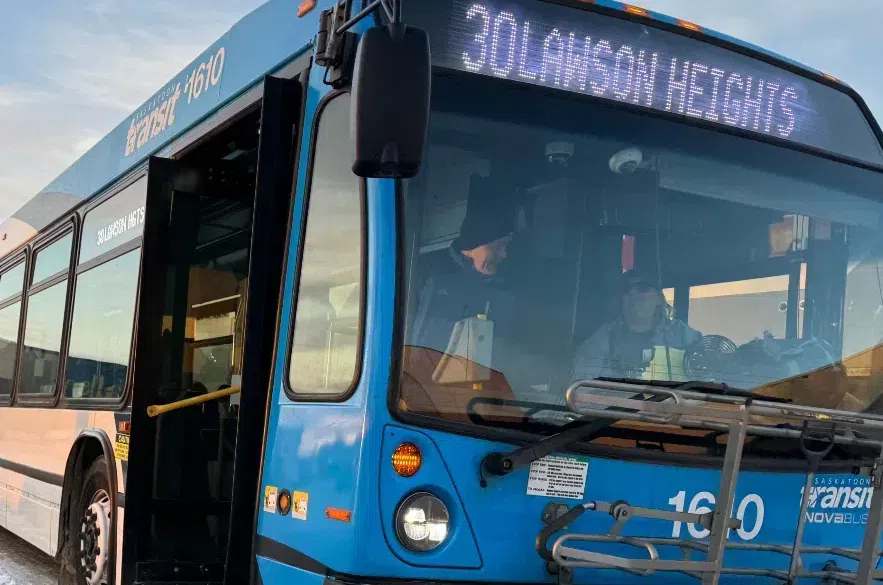Riding the bus is a little safer this year than it was in 2024, according to a transit report published by the City of Saskatoon.
In the Saskatoon Transit – Safety and Incident Report November 2025 report, the city provided updated statistics on the number of “negative interactions and incidents” on transit tracking up until September of this year.
Read more:
- Saskatoon police briefs: Man facing charges after alleged robbery on Transit bus
- Saskatoon council committee to consider changes to city bus fares
Between June to September 2025, in a month-to-month comparison to the same period in 2024, Saskatoon reported “a significant year-over-year” decline in negative interactions reported by transit staff.
These interactions involve up to three of the following: an act of aggression, assault, bodily fluid, fare dispute, harassment, intoxication, road rage, sexual harassment, a verbal altercation, and a weapon. They happen on or around transit facilities and are reported by Saskatoon Transit staff.
According to the report, there were 22 per cent fewer negative incidents in June 2025 than June 2024. That downward trend continues into September 2025, which is the latest month included in the findings.
In comparing the amount of negative incidents on a larger scale, between January 2024 to September 2024 there were 835 and from January 2025 to September 2025, that figure lowered to 792. So this year there’s been roughly five per cent fewer negative interactions.
These incidents are most often related to “social disorder issues,” the report said. Specifically, intoxication and acts of aggression make up 71 per cent of 2025’s incidents.
Honing in on the number of incidents involving a bus driver, or operator, that’s also trending to be lower in 2025 compared to 2024 and 2023. Whereas 2023 had 101 incidents reported, there were 90 in 2024 and 63 in the first nine months of 2025.
Seventy per cent of the time, these interactions involving a bus driver involve verbal altercations or acts of aggression.
Positive trends linked to introducing safety plan
The City of Saskatoon attributes these positive data trends to the Frontline Employee Safety Plan, which was launched by Saskatoon Transit in 2024, “with the purpose of improving workplace safety and fostering a culture of safety within the department.”
All of the initiatives identified in the plan were addressed by April 2025, and by June the negative incidents on transit began decreasing.
Included within that safety plan are the Fire Community Support (FCS) officers, who were first introduced in July 2024. These officers provide a visible uniformed presence on transit, riding roughly 220 buses a month.
Their purpose is to de-escalate non-violent situations on buses or transit property, and offering outreach programs to those needing them.
Since the start of this year, 89 per cent of transit incidents were within the scope of FCS officers, with Saskatoon Police Service (SPS) only required for the remaining 11 per cent.
But, Darcy Pederson, the president business agent of Amalgamated Transit Union Local 615, is skeptical of the reported downward trend in incidents, highlighting how there’s still three months of this year not yet accounted for.
“I think that we’re going to probably surpass last year’s interactions, or negative interactions, as transit calls them,” he said.
Pederson also spoke to the need for an in-between of FCS and police officers.
While FCS officers provide a “compassionate approach,” Pederson said there needs to be some type of transit security, “to keep order on the buses, enforce the fares, and just make people feel safe.”
“The majority of the incidences are intoxication and disorderly conduct and then there’s acts of aggression and verbal altercations. This is all the stuff that these peace officers or transit security could deal with,” he said.
According to Pederson, transit security could be located at “hot spots,” as defined by the routes and terminals where the greatest number of incidents are happening.
It’s not an entirely unique idea, either, with Pederson saying bigger cities like Winnipeg, Calgary and Edmonton have programs like the FCS officers in addition to transit security.
He said these new security guards should be trained by Saskatoon Transit, because going through SPS would be “way more costly.”
But SPS Deputy Chief Darren Pringle said Pederson’s proposal isn’t possible.
According to Pringle, Saskatchewan’s community safety officer policy framework isn’t the same as those in Manitoba and Alberta.
“So to be able to bring in a transit peace officer [here], that concept wouldn’t exist,” he said, instead explaining that it would need to be an Alternative Response Officer.
Read more:











